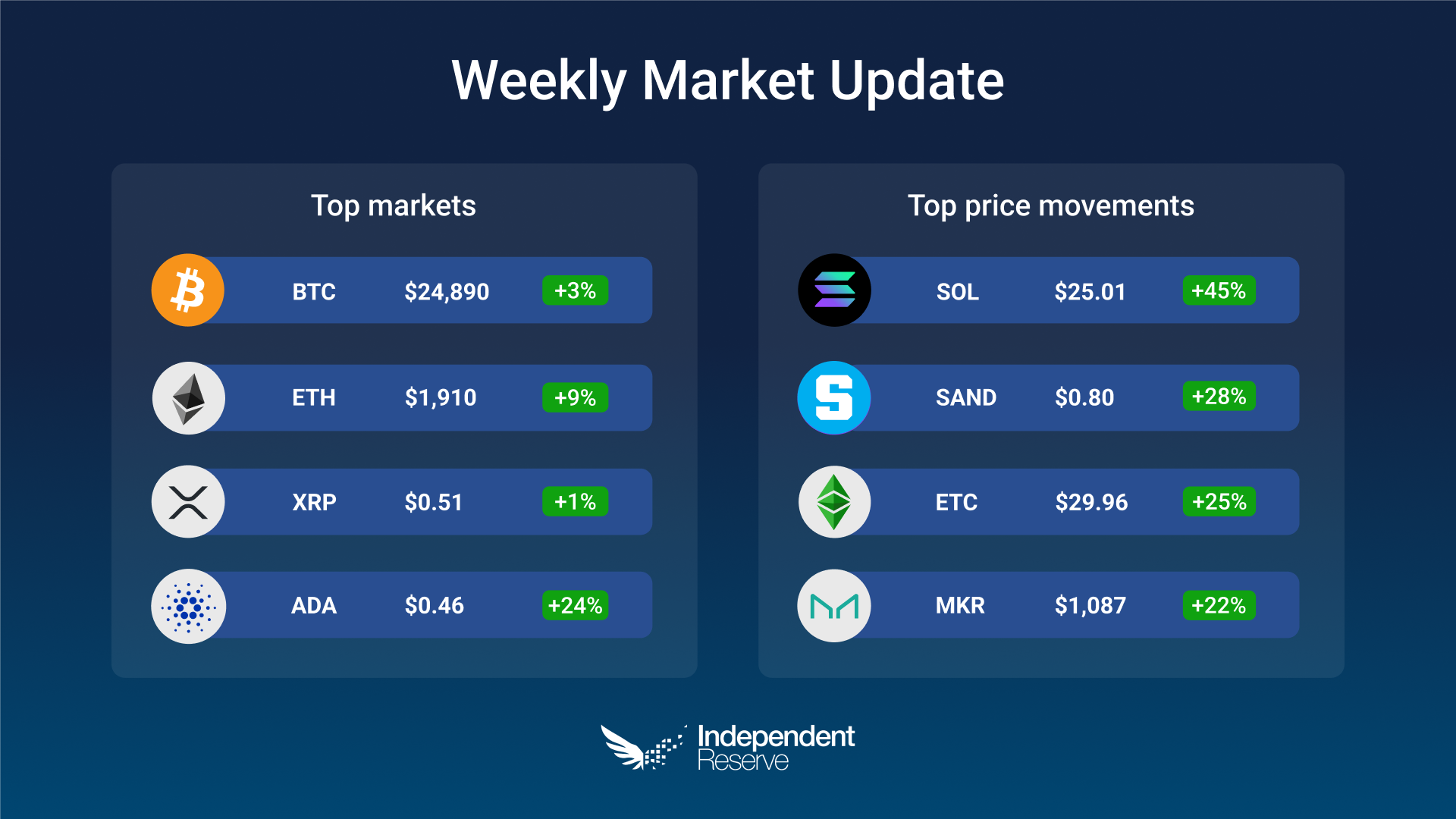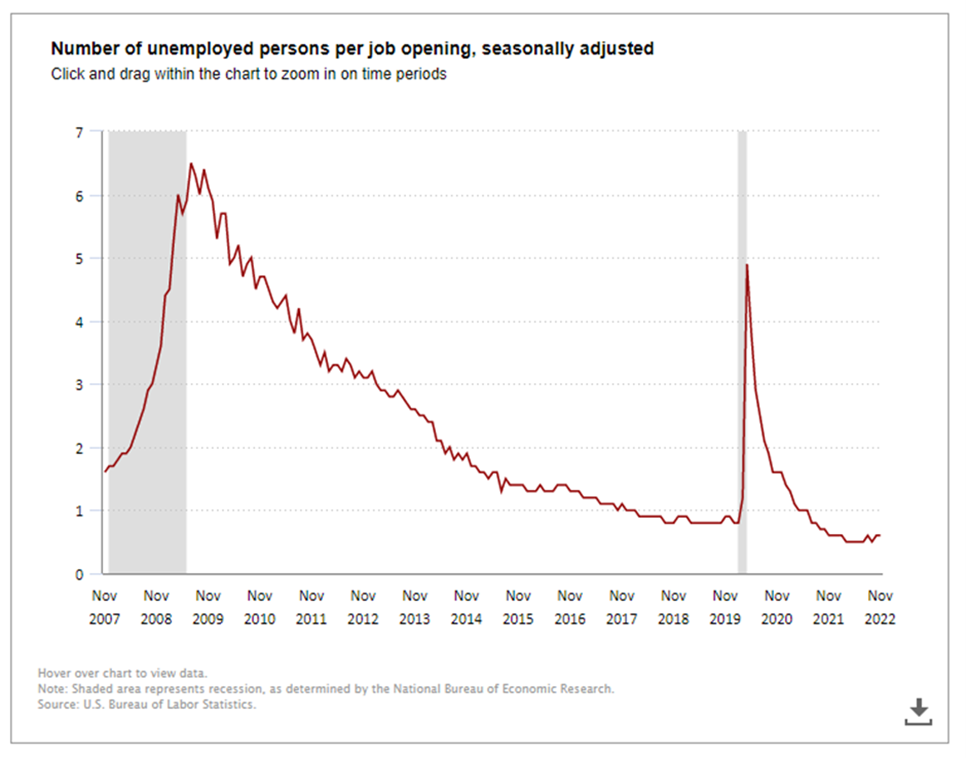In markets
Crypto markets appeared to have finally turned a corner this week after grinding along with low volatility since the collapse of FTX in November. It’s too early however to call the bottom or work out if this is just a bull trap. Pundits linked the rise to markets expecting a lower US inflation figure this week and for interest rates to peak around 5%, but in truth it’s just as likely to be the fact that no major crypto exchange or firm has collapsed in the past couple of weeks. Bitcoin has broken through the US$17K (A$24.6K) mark and is up 3% from a week ago to trade at A$17,220 (US$24,885). Ethereum gained 8.6% to trade at A$1,910 (US$1,322). Everything else was up, including Cardano (24%), Dogecoin (6%) and Polygon (7.8%). Solana gained 46% and has more than doubled in price since its lows two weeks ago. Crypto mining companies and other blockchain-linked stocks, including Riot Blockchain, Marathon Digital, Coinbase and Silvergate have all rallied by double-digit percentages on share markets.

From the OTC Desk
As we progress into 2023, Central Banks (as a collective) will remain focused on reducing inflation and carefully monitoring labour market conditions and economic growth. In general, the Reserve Bank of Australia (RBA) and the Reserve Bank of New Zealand (RBNZ) have limited economic calendars for January – the RBA meets on Tuesday the 7th of February, while the RBNZ will convene on Wednesday the 22nd of February. The US Federal Open Market Committee (FOMC) will begin their next two-day monetary policy meeting on the 31st of January.
Last week was all about US labour market data, which has remained strong. US JOLTs Job Openings came in at 10.458 million for November, relative to a 10 million expectation. US non-farm payrolls for December saw 223k additional jobs created, with the unemployment rate falling back down to 3.5% in December relative to 3.6% in November. Of note, the labour market participation rate increased to 62.3% in December relative to 62.2% in November. The number of unemployed persons per job opening remains near historic lows.

Importantly, the labour market’s strength is the primary driver of wage inflation. As unemployment rates move lower, wage inflation remains supported (in theory). Interestingly for the December US payrolls series, US average hourly earnings (YoY) came in much lower than the market forecast, at 4.6% (YoY). This Average Hourly Earnings reading (December 2022) is a full 1% lower than the peak wage inflation of March 2022! The immediate reaction from risk assets and cryptocurrencies has been incredibly positive, with the assets furthest on the risk curve and most sensitive to USD funding levels performing the best. More broadly, capital markets will need to consider market-based hypotheses of whether wage inflation may be reducing much more quickly than expected. Watch this space.
In the calendar this week, we receive the Australian monthly CPI indicator for November, which is scheduled for release on Wednesday, the 11th of January, at 11:30 am AEDT. The current expectation is an increase in the Australian inflation monthly series to 7.3% (November) versus 6.9% in October. Note that the RBA has forecast for inflation to peak in Australia during the Q4 period at circa 8%. In the US, we receive the December inflation data. Scheduled for release on Friday the 13th of January at 12:30 am AEDT, market consensus is for a December inflation of 6.5% relative to a November reading of 7.1%. US inflation will be this week’s most significant data point.
In cryptocurrencies, the surprise reduction in US wage inflation saw capital inflow into heavily discounted tokens. SOL, LDO and LTC have all outperformed, with ETH benefiting from positive price action on the back of correlated trading strategies. ETHBTC has moved from 0.07250 up to 0.07680 in the following trading sessions – confirmation of the capital flow into more risk-sensitive assets. We continue to monitor the yield on the 1yr US treasury note (4.75%) as an investment proxy for staking yields. Currently, front-end yields have not materially lowered, indicating no immediate expectation of policy change for central banks. Positively for Defi flow, the OTC desk has realised a sharp turnaround in USDT flows over the past two weeks, with buy flow now presenting. USDT pricing has profiled around 1:1 USD post the NY period.
For any further information, please feel free to reach out.
Bitcoin is 14
Bitcoin turned 14 years old this week, with the community celebrating the 14th anniversary of the mining of the ‘Genesis Genesis Block” by Satoshi Nakamoto back in 2009.
BAS opposes the proposed Singapore ban on crypto lending
The Blockchain Association of Singapore (BAS) has voiced opposition to a proposed ban on crypto firms lending tokens. An 11-page feedback document sent to the Monetary Authority of Singapore BAS argued that a ban could push local users toward unregulated offshore firms. “We are proposing a more measured and targeted approach, including doubling on educating consumers on the risks of dealing with unregulated entities and increasing enforcement activities on those engaging in regulated activities without the requisite regulatory approvals,” Chia Hock Lai, chairman of the association’s board told Bloomberg.
Ethereum’s Shanghai testnet set for February
A public testnet for the Shanghai upgrade to Ethereum is scheduled for release by the end of February. The latest core developers call saw agreement that the focus of the upgrade would almost solely be on enabling validators to finally withdraw staked ETH from the network (anyone staking ETH so far has lost access to it). Devs agreed not to add the proposed EVM improvement called ‘Ethereum Virtual Machine Object Format’ for fears it would delay Shanghai from its March target.
SBF pleads not guilty
As expected, FTX and Alameda founder Sam Bankman-Fried pleaded not guilty to all fraud charges when he appeared in court in New York. SBF can change his plea at any time up to and including, at the trial itself, which will commence on October 2. SBF’s lawyers asked the court to keep confidential the identities of two people of “considerable means” who agreed to help secure his bail. A task force by the US Attorney’s Office for the Southern District of New York has been put together to track the missing billions and investigate the whole debacle. They also set up a website for FTX’s “victims of fraud” to get in touch. Bankruptcy documents show FTX spent US$40 million (A$58M) on hotels, food and travel in just nine months last year.

(Source: Coindesk)
Wash trading the next big issue to fix
Wash trading coins on exchanges will cause the next big crypto implosion, says billionaire investor Mark Cuban. That’s where the same entity trades coins back and forth with themselves to either inflate an exchange’s volume or to inflate the level of interest in a coin. Cuban predicted 2023 would see “the discovery and removal of wash trades on central exchanges.” “There are supposedly tens of millions of dollars in trades and liquidity for tokens that have very little utilization … I don’t see how they can be that liquid,” he said. Up to 70% of the volume on unregulated exchanges is fake, according to a report by the National Bureau of Economic Research in December.
Where to from here?
Will this week’s rally continue? Analyst Capo told his 700K followers he wasn’t buying based on a couple of days of green and stated the “bearish trend was intact” and there wasn’t a “single bullish confirmation yet.” But Kaleo told his 550K followers his charts suggest Ether will hit the US$1,500 (A$2,171) range later this month and that he believes “this rally is just getting started, send it higher.”
Until next week, Happy Trading!


